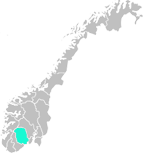



Nature's Own Water Park – Polished Rock Slabs, Round Potholes, and Crystal Clear Pools.
In the south of Nissedal, near Espestøyl farm, the Fyresåna river has polished the mountain into spectacular potholes (jettegryter), natural slides, and tranquil pools. When the sun warms the rock, Jettegrytene becomes a natural summer land – perfect for swimming, picnics, photos, and great memories.
Along a stretch of approximately 300 meters, the potholes are densely packed – from small "footbaths" to deep pools and natural slides. The narrow valley and the warm rock slabs give you a genuine "Sørlandet" (Southern Norway) feeling. Jettegrytene has been a local favorite for generations and is today among Nissedal's most photographed natural phenomena, and has been named Telemark's finest swimming spot several times.
Tip: Little shade in the riverbed – bring water, a cap/sunscreen, and a small sitting pad.
Natural and uneven terrain (rock slabs/stone). Not suitable for strollers and can be challenging for small children. No fixed surface coverage for wheelchairs all the way to the pools.
Address/Area: Reinsfoss / Espestøyl, Nissedal
Parking: Reinsfoss (road toll NOK 100)
Contact/Tourist Info: Jettegrytene AS / Treungen Gjestgiveri
Can you swim?
Yes, but at your own risk. Choose calm pools, test the depth, and be aware of slippery rock slabs.
Where do I park?
At Reinsfoss parking (fee NOK 100, payment at the toll box).
Simple standard toilet (seasonal). No kiosk – bring water/food, and take all rubbish out.




Visit Z-Museum in Treungen, Norway. Explore 50+ thematic exhibitions with rare cars,…
Hillestad Gallery opened in 1985. Since then, there have been many exhibitions featuring…
Here you can see the four largest Scandinavian carnivores: bear, wolf, wolverine and lynx…
Norways smallest cable ferry takes you and your car across the lake Nisser, from Nissedal…
What did a prosperous farm in West-Telemark look like about 200 years ago? At Kviteseid…
Kviteseid Old Church lies close to Kviteseid Bygdetun museum, on a beautiful plateau near…
Experience charming Kviteseidbyen by the Telemark Canal! Explore local cafes, shops and…
Jazz lovers flock to New Orleans, Elvis fans congregate in Memphis, ski enthusiasts…
Discover Vest-Telemark Museum! See Eidsborg Stave Church, Stålekleivloftet from 1184 and…
The history of Sondre Norheim begins in Morgedal, Telemark.
Norway's only peat museum covering production from 1896 to present day, powered by a…
Telespinn is a small environmental friendly yarn factory with sale on the farm…